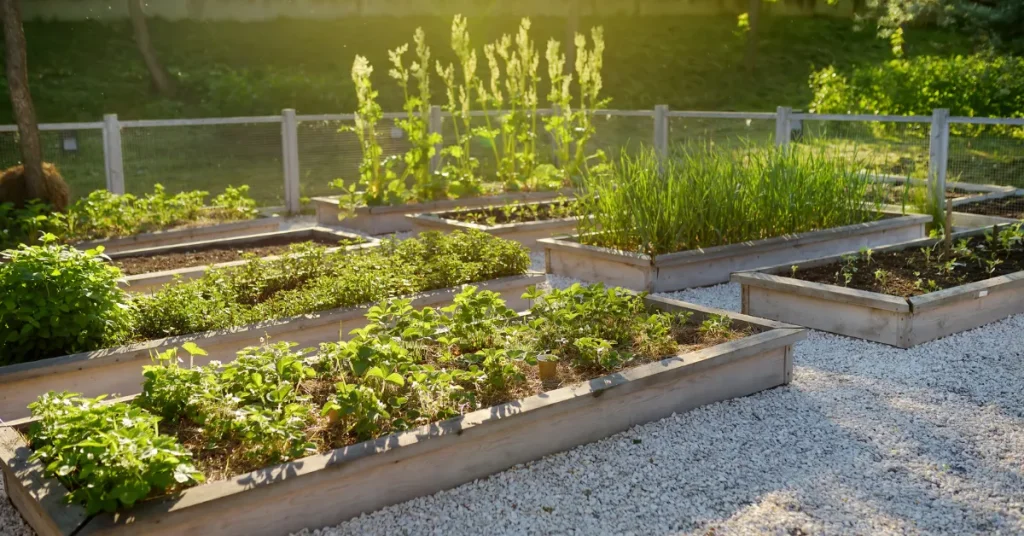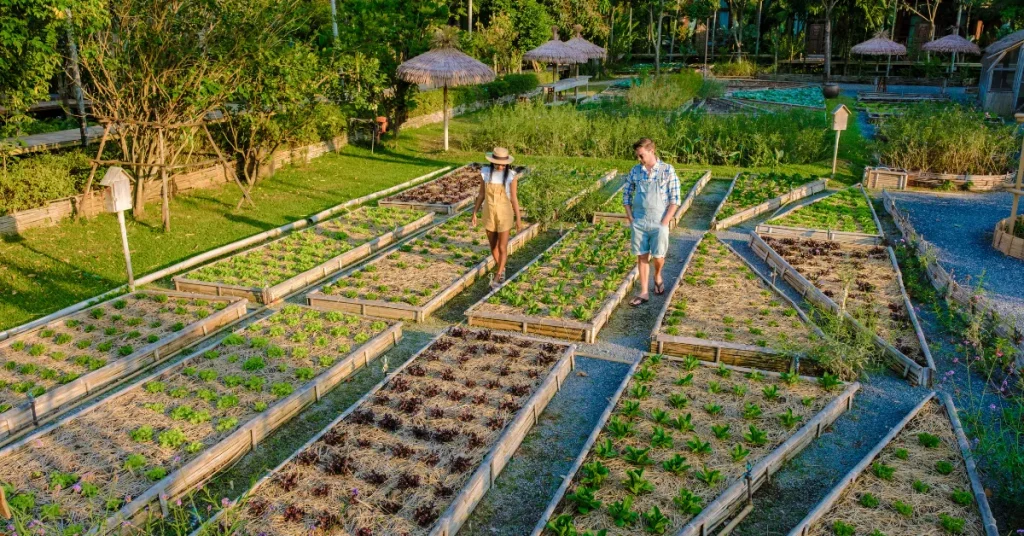A garden bed should be at least 6 to 12 inches deep. Deeper beds of up to 18 inches are beneficial for root crops and perennials.
Creating the ideal garden bed is crucial for nurturing healthy plants and bountiful harvests.
Depth is a key factor that affects soil quality, root growth, and drainage. Suitable depth ensures that plant roots have enough space to grow and access nutrients, water, and air.
A deeper bed can improve soil warmth, which is particularly beneficial for longer growing seasons.
It’s also important to consider the type of plants you intend to grow; leafy greens may thrive in shallower beds, while root vegetables like carrots and potatoes require more depth to flourish.
Proper bed depth also alleviates strain on the gardener’s back, making the gardening experience more enjoyable. An appropriately deep garden bed sets the stage for a thriving garden that can sustain vibrant plant life and yield a fruitful crop.

Digging Into Garden Bed Depths
Understanding garden bed depth is crucial for a thriving garden. It affects root growth, nutrient absorption, and water drainage. A well-chosen depth sets the foundation for healthy plants and abundant harvests.
The Role Of Depth In Plant Health
Different plants have varied root lengths. A suitable depth allows roots to spread and access nutrients. Layers that are too shallow limit growth, while excessively deep beds can require more soil and effort than necessary.
- Root aeration: Deep enough for air to reach roots.
- Moisture control: Enough room to handle water without drowning roots.
- Nutrient availability: Proper depth ensures roots tap into a rich soil blend.
Average Depths For Vegetable Gardens
Selecting the optimal depth enhances your vegetable garden’s success. Most vegetables thrive with a root zone of 6 to 12 inches. Below is a brief overview:
| Vegetable | Minimum Depth (inches) | Ideal Depth (inches) |
| Leafy Greens | 6 | 8 |
| Root Vegetables | 12 | 18 |
| Nightshades (e.g., tomatoes) | 12 | 18 |
| Legumes | 8 | 12 |
A good rule of thumb: Aim for 12 inches of depth for a versatile vegetable garden. Consider specific requirements when planning for specific plants.
Roots And Requirements
Every gardener knows roots are key to healthy plants. But how deep should a garden bed be? It’s not just about having space for plants to grow.
It’s about giving roots what they need. Roots need room to spread and pick up water and nutrients. Choosing the right depth for your garden bed can lead to a lush, vibrant, and fruitful garden.
Understanding Different Plant Root Systems
Plants have different roots systems. Some roots go deep, while others spread out close to the surface. Knowing these root systems helps you plan your garden bed depth.
- Taproots — like carrots and dandelions, dive deep down.
- Fibrous roots — like grass and onions, spread out just below the soil.
- Adventitious roots — like corn, develop from stems or leaves.
Matching Depth To Root Types
Now, let’s match garden bed depths to these root systems. Your bed’s depth depends on what you plant.
| Plant Type | Recommended Depth |
| Shallow-Rooted | 12 inches |
| Medium-Rooted | 18-24 inches |
| Deep-Rooted | 24-36 inches or more |
Shallow-rooted plants do well with a minimum of 12 inches. Think lettuce and basil.
Medium-rooted plants need 18–24 inches. Tomatoes and cucumbers are happy here.
Deep-rooted plants need at least 24–36 inches. Consider pumpkins and fruit trees.
Always check the specific requirements of your plants. Then, make your garden bed to fit.
Materials And Construction
When creating a garden bed, the right materials and construction are as crucial as the depth. A durable and well-constructed bed ensures your plants have a strong foundation. Let’s dive into selecting materials and the best construction techniques for your garden’s success.
Selecting Materials For Raised Beds
Choosing the proper materials for your raised garden beds sets the stage for their longevity and effectiveness.
Consider weather resistance, sustainability, and safety for growing food. Always opt for materials that can withstand the elements without releasing harmful substances.
- Untreated wood like cedar or redwood resists rot naturally.
- Composite materials blend wood fibers with recycled plastics.
- For longevity, galvanized steel is a robust option.
- Stone or bricks provide a timeless aesthetic but may require a higher budget and skilled construction.
Effective Construction Techniques
Building a garden bed that stands the test of time is about more than materials. Follow proven construction techniques for a robust result. Key steps include proper bed support, secure fastening, and even weight distribution.
| Action | Details |
| Corner Posts | Use sturdy posts at each corner for stable bed frames. |
| Fasteners | Choose rust-proof screws or bolts over nails for a stronger hold. |
| Supports | Place horizontal supports every 2-3 feet to prevent bulging. |
| Leveling | Ensure the top of the bed is level for consistent soil depth and water distribution. |
Construct your garden bed with care, and it will serve as a nurturing home for your plants for seasons to come. Remember, a thoughtfully constructed bed leads to a healthier, more productive garden.
Soil Considerations

The foundation of any thriving garden lies beneath the surface. The depth of a garden bed greatly impacts the type of soil you’ll need and ultimately, the success of your plants. A closer look into soil considerations reveals why depth is critical.
This knowledge ensures your green companions flourish. Different plants have varying needs, but a balance of nutrients, composition, and depth sets the stage for a bountiful garden.
Ideal Soil Composition For Various Depths
Shallow garden beds, often up to 6 inches deep, are perfect for herbs and leafy greens. They prefer soil with more organic material which aids quick root growth. Medium-depth beds, around 6 to 12 inches, welcome a variety of vegetables.
These require a well-draining mix with balanced nutrients. Deep beds, exceeding 12 inches, cater to root vegetables and perennials. They thrive in soil with layers of compost, loam, and sand that enable deep rooting.
- Herbs and greens: Compost-rich topsoil
- Vegetables: Mixed loam with compost and vermiculite
- Root crops: Loam, compost, and coarse sand for drainage
Amending Soil For Optimal Growth
Even the best soil becomes tired after seasons of growth. Rejuvenating that soil is essential. Incorporate organic matter like compost to restart its vitality. Test soil pH to ensure it’s balanced, aiming for a range between 6.0 and 7.0 for most plants.
Add nutrients such as nitrogen, phosphorus, and potassium based on the test’s recommendations. These nutrients support root development, flowering, and overall plant health.
| Depth | Amend with | Frequency |
| Shallow (up to 6″) | Compost, worm castings | Every planting season |
| Medium (6-12″) | Balanced compost mix | Twice a year |
| Deep (over 12″) | Compost, sand, fertilizers | Once a year |
Ensure beds retain their edge with regular maintenance. Layer mulch on top to preserve moisture and suppress weeds. With the right soil depth and upkeep, your garden bed will become a haven for vibrant plant life.
Troubleshooting Deep Garden Beds
Deep garden beds can yield bountiful harvests. Yet, they may also face unique challenges. Identifying and fixing these early ensures a flourishing garden. Let us dive into common issues and their solutions.
Dealing With Drainage Issues
Poor drainage can mean trouble for deep garden beds. Waterlogged soil harms plant roots. Here are steps to maintain good drainage:
- Add organic matter: This improves soil texture.
- Install a drainage system: A bed with built-in drainage helps a lot.
- Raise the beds: Elevated soil levels encourage water runoff.
- Check soil layers: Ensure fine soil isn’t clogging the bottom.
Always monitor after rain. Standing water signals an issue. Act fast to fix it.
Root-bound Concerns And Prevention
Root-bound plants struggle to grow. Their roots need room. To prevent this:
- Choose the right depth: Match bed depth with plant root length.
- Pay attention to spacing: More space means less competition.
- Prune roots: For perennials, trim roots each season.
- Rotate crops: Plant in new spots to prevent soil exhaustion.
Healthy roots equal healthy plants. Keep an eye out for roots at the surface or plants looking stressed.
By tackling these tips, your deep garden beds can thrive, producing lush, vibrant plants.
Adapting Garden Bed Depth

An essential element for a flourishing garden is the depth of its beds. The right depth can lead to abundant yields and healthy plants. Let’s dive into how to adapt the depth of garden beds to maximize growth and ensure the vitality of your garden ecosystem.
Adjusting Depths For Crop Rotation
Adapting garden bed depth plays a pivotal role in crop rotation. It’s not just about the initial digging; it’s about ongoing management for optimal plant health. Here are steps to adjust bed depths for different crops:
- Identify crop requirements: Different crops have varying root depths.
- Annual deepening: Each year, deepen beds for root crops like carrots and potatoes.
- Maintain shallow beds for herbs and leafy greens.
This practice encourages healthy soil structure and reduces pest buildup.
Creating Multi-level Beds For Biodiversity
Biodiversity is crucial for a garden’s resilience. Multi-level beds create distinct environments for a range of plants. Here’s how to build them:
- Design layout: Plan for varying bed heights.
- Layer soil: Use a mix suitable for different plants.
- Integrate companion plants: Pair plants that thrive together.
This structure supports a balance of nutrients and habitats for beneficial insects and microorganisms.
FAQs About How Deep Should A Garden Bed Be
What Is The Ideal Depth For Garden Beds?
The ideal depth for garden beds typically ranges from 12 to 18 inches. This allows ample space for most plant roots to grow, ensures good drainage, and provides enough soil to retain moisture and nutrients.
Does Garden Bed Depth Affect Plant Growth?
Yes, garden bed depth can significantly impact plant growth. Deeper beds offer more room for roots to expand, thus supporting healthier, more robust plant development. However, too shallow beds may lead to poor root development and reduced plant vigor.
Can Garden Beds Be Too Deep?
Garden beds can be too deep, which might be unnecessary and costly. Very deep beds could make it harder to reach plants and may require more soil than needed. Ideal depth should balance root space, water retention, and ease of access.
How To Determine The Depth Of A Raised Garden Bed?
To determine the depth of a raised garden bed, consider the root depth of plants you wish to grow, local soil conditions, and drainage. Typically, 12 to 18 inches will suffice, but root crops might benefit from up to 24 inches.
Conclusion
Deciding on the ideal depth for your garden bed brings numerous rewards. It enhances root growth, plant health, and yield.
Aim for at least 12 inches, customized to your plant selections. Remember, depth ensures a thriving garden. Happy gardening and bountiful harvests await your well-planned beds!
Resources:
1. https://extension.psu.edu/how-to-construct-a-raised-bed-in-the-garden
